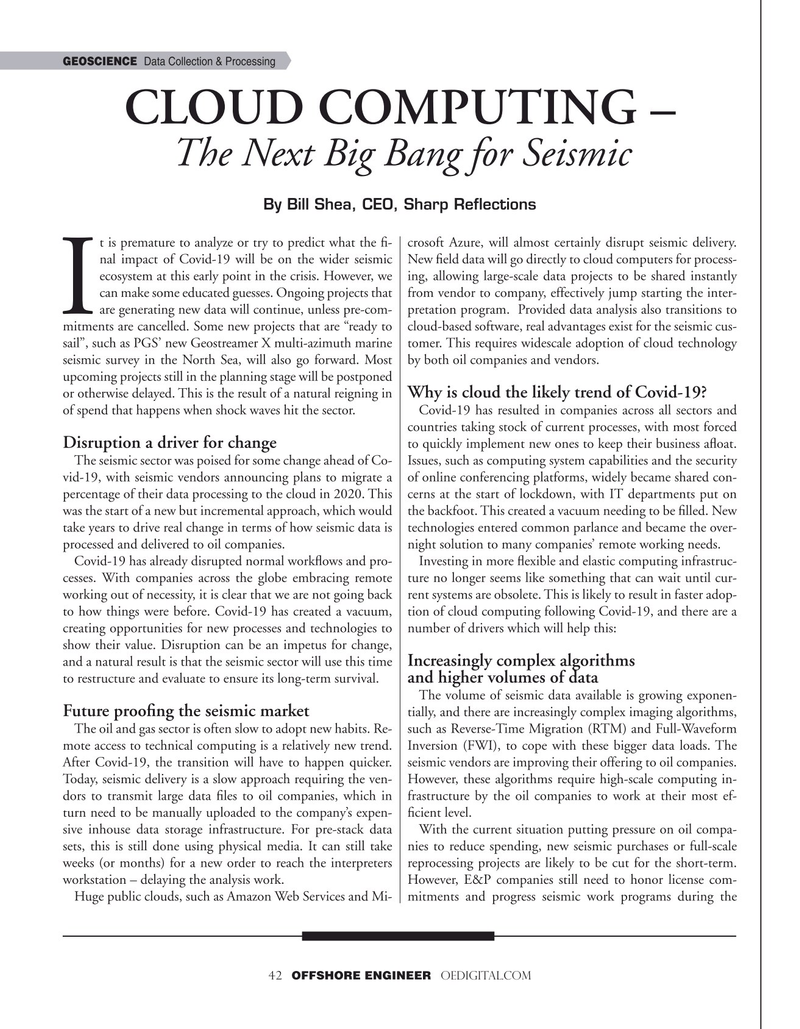
Page 42: of Offshore Engineer Magazine (Sep/Oct 2020)
Read this page in Pdf, Flash or Html5 edition of Sep/Oct 2020 Offshore Engineer Magazine
GEOSCIENCE Data Collection & Processing
CLOUD COMPUTING –
The Next Big Bang for Seismic
By Bill Shea, CEO, Sharp Reflections t is premature to analyze or try to predict what the f- crosoft Azure, will almost certainly disrupt seismic delivery. nal impact of Covid-19 will be on the wider seismic New feld data will go directly to cloud computers for process- ecosystem at this early point in the crisis. However, we ing, allowing large-scale data projects to be shared instantly can make some educated guesses. Ongoing projects that from vendor to company, effectively jump starting the inter-
I are generating new data will continue, unless pre-com- pretation program. Provided data analysis also transitions to mitments are cancelled. Some new projects that are “ready to cloud-based software, real advantages exist for the seismic cus- sail”, such as PGS’ new Geostreamer X multi-azimuth marine tomer. This requires widescale adoption of cloud technology seismic survey in the North Sea, will also go forward. Most by both oil companies and vendors.
upcoming projects still in the planning stage will be postponed or otherwise delayed. This is the result of a natural reigning in
Why is cloud the likely trend of Covid-19?
of spend that happens when shock waves hit the sector. Covid-19 has resulted in companies across all sectors and countries taking stock of current processes, with most forced to quickly implement new ones to keep their business afoat.
Disruption a driver for change
The seismic sector was poised for some change ahead of Co- Issues, such as computing system capabilities and the security vid-19, with seismic vendors announcing plans to migrate a of online conferencing platforms, widely became shared con- percentage of their data processing to the cloud in 2020. This cerns at the start of lockdown, with IT departments put on was the start of a new but incremental approach, which would the backfoot. This created a vacuum needing to be flled. New take years to drive real change in terms of how seismic data is technologies entered common parlance and became the over- processed and delivered to oil companies. night solution to many companies’ remote working needs.
Covid-19 has already disrupted normal workfows and pro- Investing in more fexible and elastic computing infrastruc- cesses. With companies across the globe embracing remote ture no longer seems like something that can wait until cur- working out of necessity, it is clear that we are not going back rent systems are obsolete. This is likely to result in faster adop- to how things were before. Covid-19 has created a vacuum, tion of cloud computing following Covid-19, and there are a creating opportunities for new processes and technologies to number of drivers which will help this: show their value. Disruption can be an impetus for change,
Increasingly complex algorithms and a natural result is that the seismic sector will use this time to restructure and evaluate to ensure its long-term survival. and higher volumes of data
The volume of seismic data available is growing exponen-
Future proofng the seismic market tially, and there are increasingly complex imaging algorithms,
The oil and gas sector is often slow to adopt new habits. Re- such as Reverse-Time Migration (RTM) and Full-Waveform mote access to technical computing is a relatively new trend. Inversion (FWI), to cope with these bigger data loads. The
After Covid-19, the transition will have to happen quicker. seismic vendors are improving their offering to oil companies.
Today, seismic delivery is a slow approach requiring the ven- However, these algorithms require high-scale computing in- dors to transmit large data fles to oil companies, which in frastructure by the oil companies to work at their most ef- turn need to be manually uploaded to the company’s expen- fcient level. sive inhouse data storage infrastructure. For pre-stack data With the current situation putting pressure on oil compa- sets, this is still done using physical media. It can still take nies to reduce spending, new seismic purchases or full-scale weeks (or months) for a new order to reach the interpreters reprocessing projects are likely to be cut for the short-term. workstation – delaying the analysis work. However, E&P companies still need to honor license com-
Huge public clouds, such as Amazon Web Services and Mi- mitments and progress seismic work programs during the 42 OFFSHORE ENGINEER OEDIGITAL.COM

 41
41

 43
43